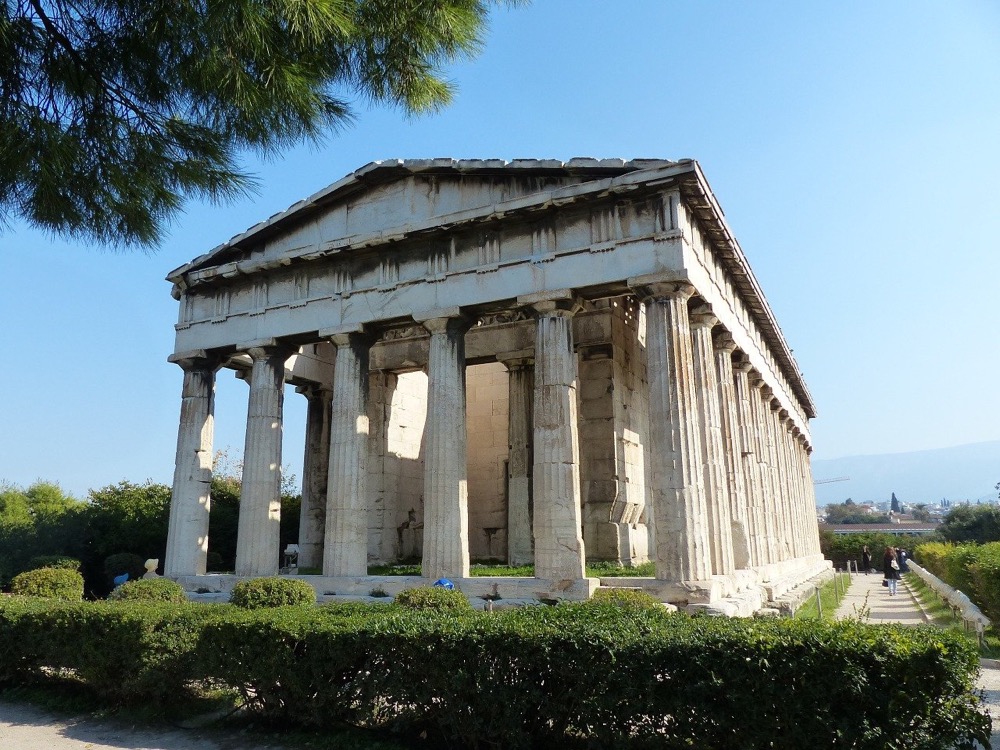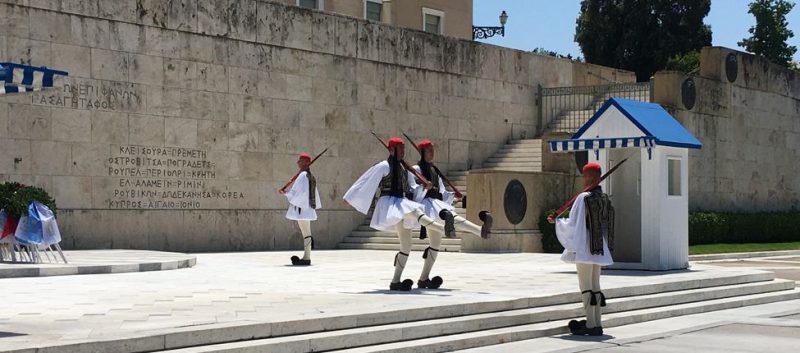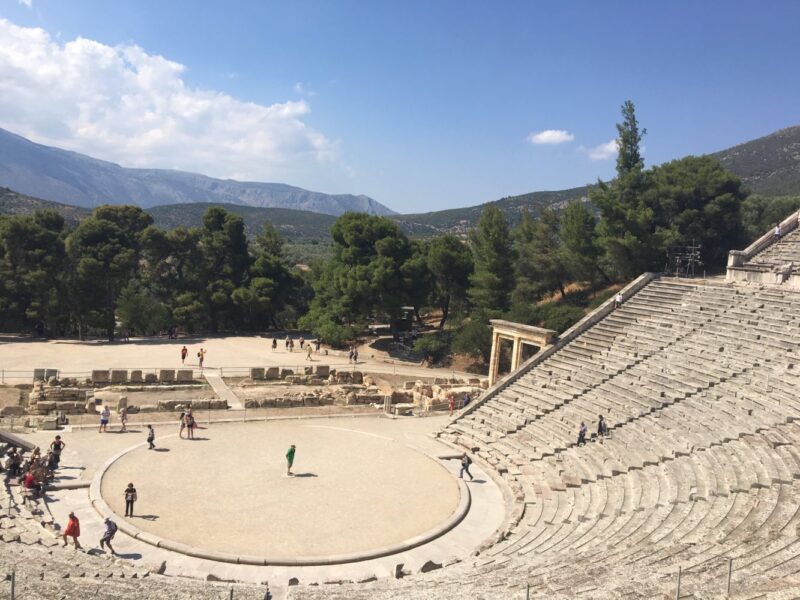Ancient Agora of Athens, also called Classical Agora, where democracy was born and flourished, lies northwest of the Acropolis. Its name comes from the verb αγειρω, which means “to gather ” in ancient Greek. Indeed, it was the center of Athens’ political, administrative, philosophical, cultural and commercial life. The buildings, monuments and artefacts revealed by the excavations bear witness to this.
Be careful not to confuse the Ancient Agora of Athens or Greek Agora, whose entrance is on Adrianou Street (map), with the Roman Agora (Roman Forum of Athens), Polignotou street (map)…
Practical information for visiting the Ancient Agora in Athens
How to get there?
The easiest way to get there is on foot from Monastiraki Square (3 mins. walk). The Monastiraki metro station serves lines 1 and 3. Then head towards Adrianou Street, which runs alongside the Agora and the metro line. The entrance is opposite the charming Church of the Apostle Philip.
Address: Adrianou 24, Athens – On Google Maps –
Opening times and prices
Open daily from 8:00 a.m. to 6:30 p.m. (8 p.m. in summer). As opening times vary, we advise you to check the official website before your visit.
Full price ticket: €20 / Reduced: €10
European citizens over 65 benefit from a reduced rate of €10 between October 1 and May 31. During the summer months of June to September, the full rate also applies.
Admission to the Greek Agora is free for European children and young people up to the age of 25, for non-European children up to the age of 18, and for disabled people and those accompanying them, on presentation of proof…
Agora is also free for everyone on:
- March 6 – Melina Mercouri tribute day
- April 18 – International Monuments Day
- May 18 – International Museum Day
- The last weekend of September each year (European Cultural Heritage Days)
- October 28 – ochi day
- Every first and third Sunday of the month from November 1st to March 31st
Where can I buy tickets for the Ancient Agora in Athens?
Tickets can be purchased directly at the entrance to the Ancient Agora, or online here.
On Get Your Guide, you can also buy a full-price ticket and its audioguide in english for a few euros more. (Be careful to choose the Agora site audioguide and not the Athens city audioguide).
It’s also possible to buy a combined ticket Acropolis + Agora, or this combined ticket Ancient Agora + Roman Agora. Non refundable.
Visit the Agora with a guide
Small-group tour: Local agency Alternative Athens offers a full Mythological tour (4h). It lasts all morning and covers many of the city’s must-see sites, including the Ancient Agora (as well as the Acropolis and Parthenon, Temple of Zeus).
Audioguide tour: We tested the Clio Muse audioguide of the Ancient Agora of Athens, which is included with your ticket. With its english version, it’s a good low-cost option. Although complete, we found some passages lengthy. Some difficulty in finding our way between the audioguide and the site. There’s also a 3D tour of the Agora, but we haven’t tried it out yet.
The Ancient Agora, the nerve center of ancient Athens
The first traces of life in the Ancient Agora of Athens date back to the Neolithic period (3000 BC). However, it was from the 6th century BC onwards, and for 800 years, that this square plain – bounded by the Areopagus hill to the south and the Kolonos Agoraios hill to the west – constituted the omphalos of Athens, the city center. In fact, this large open square is the venue for social, cultural and commercial activities, as well as religious festivals, theatrical events and games.
Athenians and Athenian women alike (the idea of the Athenian woman as a shut-in is increasingly subjective…) strolled around the Agora to do their shopping, talk politics or philosophy. For their part, young people came to listen to the grand masters, train physically and also consult the army call-up lists.
Thus, the Ancient Agora was the seat of the most important institutions of Athenian democracy. As early as the 6th century BC, public buildings were erected along the “West Street”.
A short tour of the Agora administrative district
The Bouleuterion was the city council. It was made up of 500 deputies representing the 10 Athenian tribes in groups of 50 men. This council collected draft laws, which were then voted on by the People’s Assembly, the Ecclesia.
Next door, the circular building known as Tholos or Skias (470/465 BC) alternately housed 50 of these deputies, the prytanes. They served the town for 35 or 36 days a year, and were housed and fed by the city. In the event of unforeseen danger, 17 of them remained on call, even at night, so that they could enter the session at any time. The city’s official weights and measures were also kept in the Tholos.
Still on the “west street” is the Metrôon, where the city’s public documents, decrees, laws and financial lists were kept.

A place to live and worship
The Hephaestheion, the Doric temple of Hephaestus and Athena Ergane (460-415 BC), dominates the summit of the Kolonos Agoraios hill. It is very well preserved. Hephaestus protected metallurgy and Athena craftsmanship. Sometimes it’s also called Theseion – Temple of Theseus – because its north and south friezes depict the exploits of the Athenian hero.
The Agora was also home to the mint, numerous stores, craftsmen’s workshops, altars, sanctuaries, fountains, etc. Similarly, several important streets crossed the Agora, such as the street of the Panathenaeums (a festival held in honor of the goddess Athena), West Street, Piraeus street, Areopagus street or marble street.
As for monument to the Eponymous Heroes (330 BC), of which only the base remains, it supported the ten bronze statues of the legendary heroes who gave their names to the ten Athenian tribes.
The stoas, meaning “porticoes”, such as the Poikile stoa or the Vassileios stoa, housed philosophical schools. Great names such as Socrates and Zeno taught here.
Later, Roman buildings appeared on the Agora. The Gymnasium or Giant’s Palace was built on the ruins of Agrippa’s Odeon. Similarly, the Church of the Holy Apostles, dating from 1000 AD, represents the Agora’s Byzantine period.
The Agora today
After the liberation of Greece, the Greek Archaeological Society began excavations, followed by archaeologists from the American School of Classical Studies, who restored the Attalus portico from 1953 to 1956. This imposing building, dating from the 2nd century BC, was a gift to the city from Attalus II, King of Pergamon. It housed 42 stores on two floors. As a result, Attalus’ portico can be said to have been the history’s first shopping mall.
It now houses the Museum of the Ancient Agora of Athens . Its rooms display objects from excavations in the Agora spanning the period from 3,000 BC to the Roman period.
Finally, according to mythological legends, the vast space of the Agora was planted with trees and flowers linked to the divinities. And today, you can still see the same flora…
And after your visit?
There are many bars, taverns and restaurants around the Agora. We recommend some of them here.
To contact the Ancient Greek Agora directly: Tel +30 210 3210185 / Mail: efaath@culture.gr / Website




